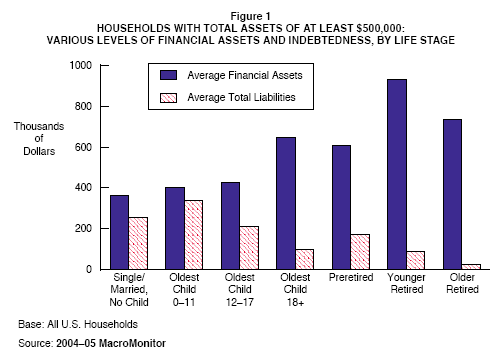Why Age, Income, or Assets Don't Work: The Dangers of One-Dimensional Targeting MacroMonitor Marketing Report Vol. VII, No. 4 December 2005
How old are they?
What's their income?
We're only interested in clients with assets over $500,000.
Many financial institutions continue to target potential customers using oversimplified one-dimensional marketing strategies. However, in the past decade, evidence has been growing that using age, income, or even assets alone to define consumer segments is losing its effectiveness to create cohesive, distinct groups with unique financial needs.
We believe that to understand, segment, and serve financial consumers in today's marketplace, researchers require at least two, if not more, carefully selected dimensions that fit with a financial institution's products, services, channel strengths, and strategic objectives. Institutions that continue to use univariate qualifiers commit two errors: They waste their resources on targeting households that don't fit their target objectives, and they miss targeting households that do fit their larger objectives.
In these days of rapidly dropping response rates to all forms of direct marketing, combined with an environment of general consumer disengagement, financial providers need to optimize their offerings not only to control their costs and use their resources more efficiently and effectively, but also out of respect for their existing and potential customers' limited resource of time.
What's their income?
We're only interested in clients with assets over $500,000.
Many financial institutions continue to target potential customers using oversimplified one-dimensional marketing strategies. However, in the past decade, evidence has been growing that using age, income, or even assets alone to define consumer segments is losing its effectiveness to create cohesive, distinct groups with unique financial needs.
- Age segmentation alone no longer works. Because of expanded life expectancy, child-rearing years are extending well beyond the twenties and thirties, working years are extending into the seventies and even eighties, and retirement, of course, doesn't necessarily start at age 65. Consequently, age no longer works as a differentiator of segments with cohesive financial needs.
- Income segmentation alone no longer works. Setting a household income threshold as a marketing target focuses on a household's income but not on its spending patterns. An annual income of $100,000 has totally different meanings to each household, depending on whether the income is from one salary or two or if it is from investments. And a household income of $100,000 will also have different meanings depending on the number of household members it supports. Whether the household is in New York City or in Des Moines, Iowa, also obviously makes a huge difference.
- Asset segmentation alone no longer works. Some financial providers establish a simple asset threshold—similar to establishing a target income threshold—particularly when targeting affluent households. By arbitrarily selecting a target of affluent households with, for example, at least half a million dollars in total assets, a financial institution inevitably winds up with a wide and diverse set of customers with various levels of financial resources and financial priorities. For households with children in college, households with disabled family members, households with a business, households entering retirement, or households with highly leveraged real estate, the relative level of assets is at best an incomplete measure of their true wealth.
 |
We believe that to understand, segment, and serve financial consumers in today's marketplace, researchers require at least two, if not more, carefully selected dimensions that fit with a financial institution's products, services, channel strengths, and strategic objectives. Institutions that continue to use univariate qualifiers commit two errors: They waste their resources on targeting households that don't fit their target objectives, and they miss targeting households that do fit their larger objectives.
In these days of rapidly dropping response rates to all forms of direct marketing, combined with an environment of general consumer disengagement, financial providers need to optimize their offerings not only to control their costs and use their resources more efficiently and effectively, but also out of respect for their existing and potential customers' limited resource of time.